PONTIAC TORRENT 2007 Owners Manual
Manufacturer: PONTIAC, Model Year: 2007, Model line: TORRENT, Model: PONTIAC TORRENT 2007Pages: 490, PDF Size: 2.71 MB
Page 421 of 490
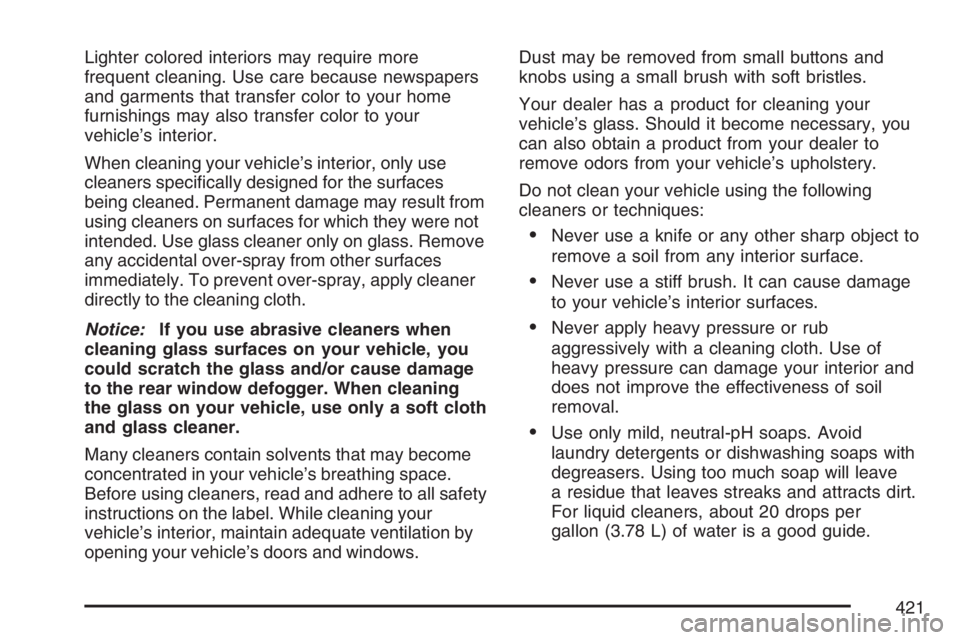
Lighter colored interiors may require more
frequent cleaning. Use care because newspapers
and garments that transfer color to your home
furnishings may also transfer color to your
vehicle’s interior.
When cleaning your vehicle’s interior, only use
cleaners speci�cally designed for the surfaces
being cleaned. Permanent damage may result from
using cleaners on surfaces for which they were not
intended. Use glass cleaner only on glass. Remove
any accidental over-spray from other surfaces
immediately. To prevent over-spray, apply cleaner
directly to the cleaning cloth.
Notice:If you use abrasive cleaners when
cleaning glass surfaces on your vehicle, you
could scratch the glass and/or cause damage
to the rear window defogger. When cleaning
the glass on your vehicle, use only a soft cloth
and glass cleaner.
Many cleaners contain solvents that may become
concentrated in your vehicle’s breathing space.
Before using cleaners, read and adhere to all safety
instructions on the label. While cleaning your
vehicle’s interior, maintain adequate ventilation by
opening your vehicle’s doors and windows.Dust may be removed from small buttons and
knobs using a small brush with soft bristles.
Your dealer has a product for cleaning your
vehicle’s glass. Should it become necessary, you
can also obtain a product from your dealer to
remove odors from your vehicle’s upholstery.
Do not clean your vehicle using the following
cleaners or techniques:
Never use a knife or any other sharp object to
remove a soil from any interior surface.
Never use a stiff brush. It can cause damage
to your vehicle’s interior surfaces.
Never apply heavy pressure or rub
aggressively with a cleaning cloth. Use of
heavy pressure can damage your interior and
does not improve the effectiveness of soil
removal.
Use only mild, neutral-pH soaps. Avoid
laundry detergents or dishwashing soaps with
degreasers. Using too much soap will leave
a residue that leaves streaks and attracts dirt.
For liquid cleaners, about 20 drops per
gallon (3.78 L) of water is a good guide.
421
Page 422 of 490
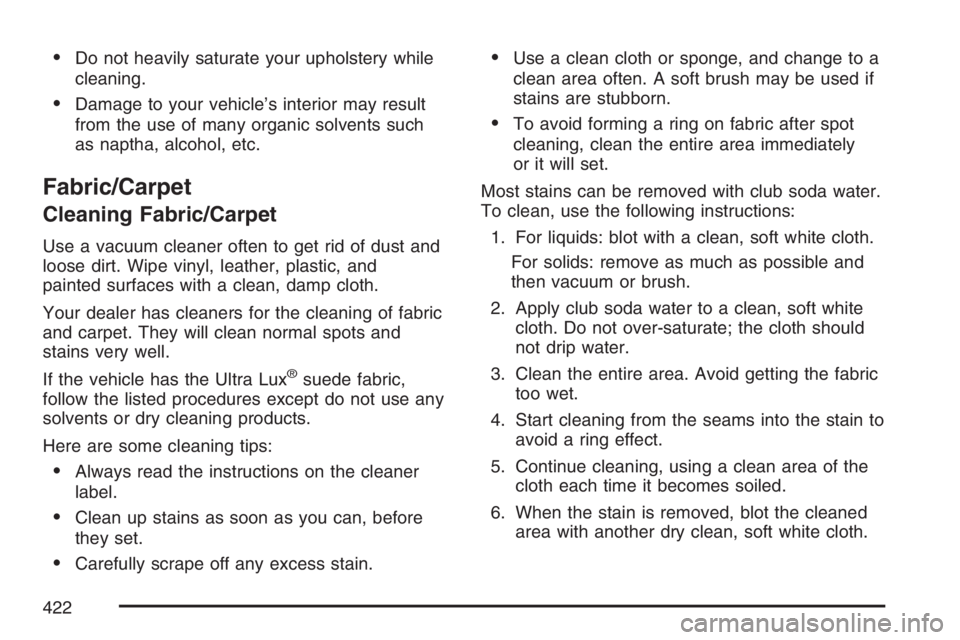
Do not heavily saturate your upholstery while
cleaning.
Damage to your vehicle’s interior may result
from the use of many organic solvents such
as naptha, alcohol, etc.
Fabric/Carpet
Cleaning Fabric/Carpet
Use a vacuum cleaner often to get rid of dust and
loose dirt. Wipe vinyl, leather, plastic, and
painted surfaces with a clean, damp cloth.
Your dealer has cleaners for the cleaning of fabric
and carpet. They will clean normal spots and
stains very well.
If the vehicle has the Ultra Lux
®suede fabric,
follow the listed procedures except do not use any
solvents or dry cleaning products.
Here are some cleaning tips:
Always read the instructions on the cleaner
label.
Clean up stains as soon as you can, before
they set.
Carefully scrape off any excess stain.
Use a clean cloth or sponge, and change to a
clean area often. A soft brush may be used if
stains are stubborn.
To avoid forming a ring on fabric after spot
cleaning, clean the entire area immediately
or it will set.
Most stains can be removed with club soda water.
To clean, use the following instructions:
1. For liquids: blot with a clean, soft white cloth.
For solids: remove as much as possible and
then vacuum or brush.
2. Apply club soda water to a clean, soft white
cloth. Do not over-saturate; the cloth should
not drip water.
3. Clean the entire area. Avoid getting the fabric
too wet.
4. Start cleaning from the seams into the stain to
avoid a ring effect.
5. Continue cleaning, using a clean area of the
cloth each time it becomes soiled.
6. When the stain is removed, blot the cleaned
area with another dry clean, soft white cloth.
422
Page 423 of 490
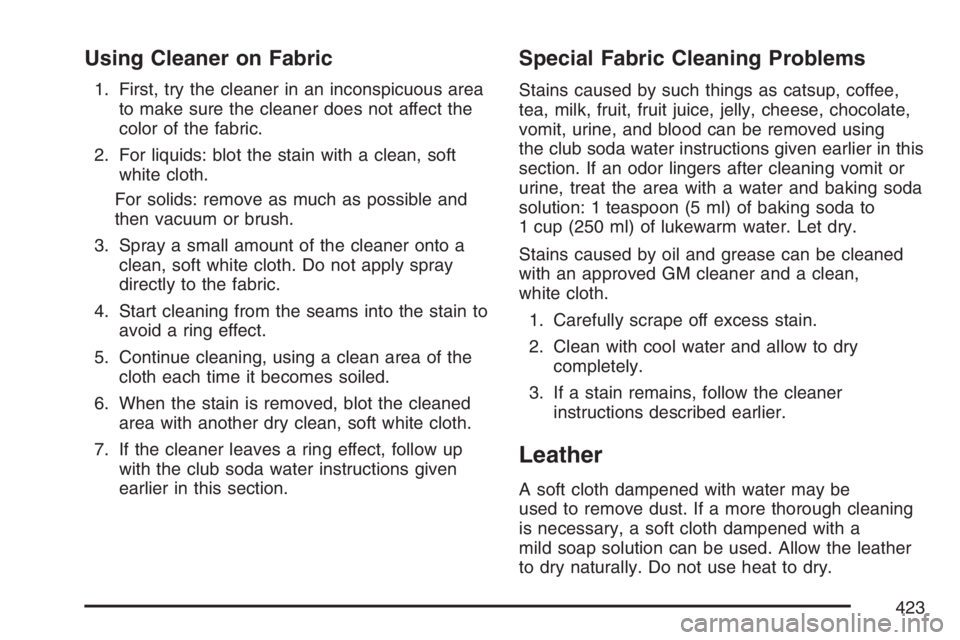
Using Cleaner on Fabric
1. First, try the cleaner in an inconspicuous area
to make sure the cleaner does not affect the
color of the fabric.
2. For liquids: blot the stain with a clean, soft
white cloth.
For solids: remove as much as possible and
then vacuum or brush.
3. Spray a small amount of the cleaner onto a
clean, soft white cloth. Do not apply spray
directly to the fabric.
4. Start cleaning from the seams into the stain to
avoid a ring effect.
5. Continue cleaning, using a clean area of the
cloth each time it becomes soiled.
6. When the stain is removed, blot the cleaned
area with another dry clean, soft white cloth.
7. If the cleaner leaves a ring effect, follow up
with the club soda water instructions given
earlier in this section.
Special Fabric Cleaning Problems
Stains caused by such things as catsup, coffee,
tea, milk, fruit, fruit juice, jelly, cheese, chocolate,
vomit, urine, and blood can be removed using
the club soda water instructions given earlier in this
section. If an odor lingers after cleaning vomit or
urine, treat the area with a water and baking soda
solution: 1 teaspoon (5 ml) of baking soda to
1 cup (250 ml) of lukewarm water. Let dry.
Stains caused by oil and grease can be cleaned
with an approved GM cleaner and a clean,
white cloth.
1. Carefully scrape off excess stain.
2. Clean with cool water and allow to dry
completely.
3. If a stain remains, follow the cleaner
instructions described earlier.
Leather
A soft cloth dampened with water may be
used to remove dust. If a more thorough cleaning
is necessary, a soft cloth dampened with a
mild soap solution can be used. Allow the leather
to dry naturally. Do not use heat to dry.
423
Page 424 of 490
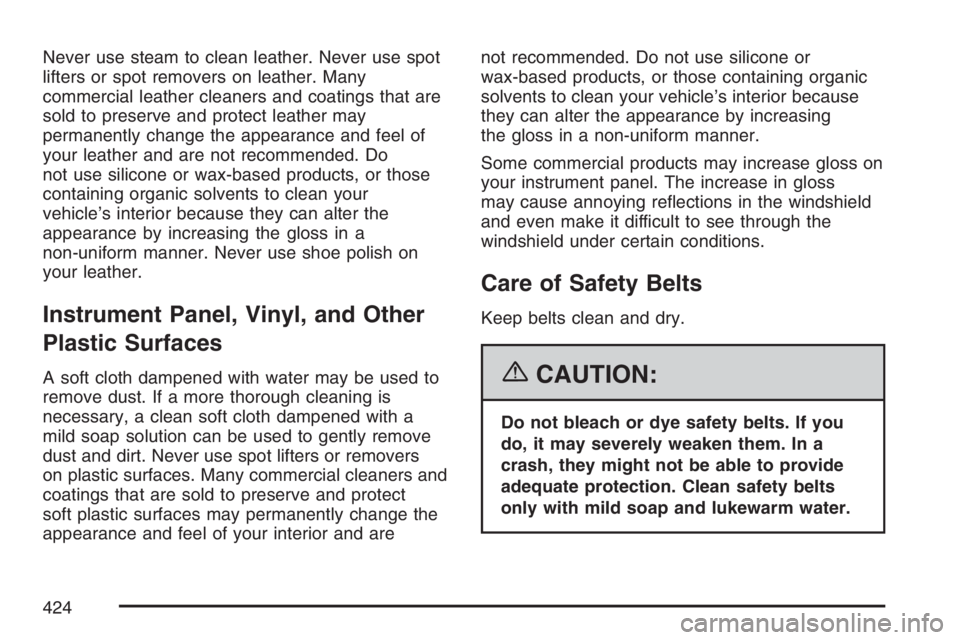
Never use steam to clean leather. Never use spot
lifters or spot removers on leather. Many
commercial leather cleaners and coatings that are
sold to preserve and protect leather may
permanently change the appearance and feel of
your leather and are not recommended. Do
not use silicone or wax-based products, or those
containing organic solvents to clean your
vehicle’s interior because they can alter the
appearance by increasing the gloss in a
non-uniform manner. Never use shoe polish on
your leather.
Instrument Panel, Vinyl, and Other
Plastic Surfaces
A soft cloth dampened with water may be used to
remove dust. If a more thorough cleaning is
necessary, a clean soft cloth dampened with a
mild soap solution can be used to gently remove
dust and dirt. Never use spot lifters or removers
on plastic surfaces. Many commercial cleaners and
coatings that are sold to preserve and protect
soft plastic surfaces may permanently change the
appearance and feel of your interior and arenot recommended. Do not use silicone or
wax-based products, or those containing organic
solvents to clean your vehicle’s interior because
they can alter the appearance by increasing
the gloss in a non-uniform manner.
Some commercial products may increase gloss on
your instrument panel. The increase in gloss
may cause annoying re�ections in the windshield
and even make it difficult to see through the
windshield under certain conditions.
Care of Safety Belts
Keep belts clean and dry.
{CAUTION:
Do not bleach or dye safety belts. If you
do, it may severely weaken them. In a
crash, they might not be able to provide
adequate protection. Clean safety belts
only with mild soap and lukewarm water.
424
Page 425 of 490
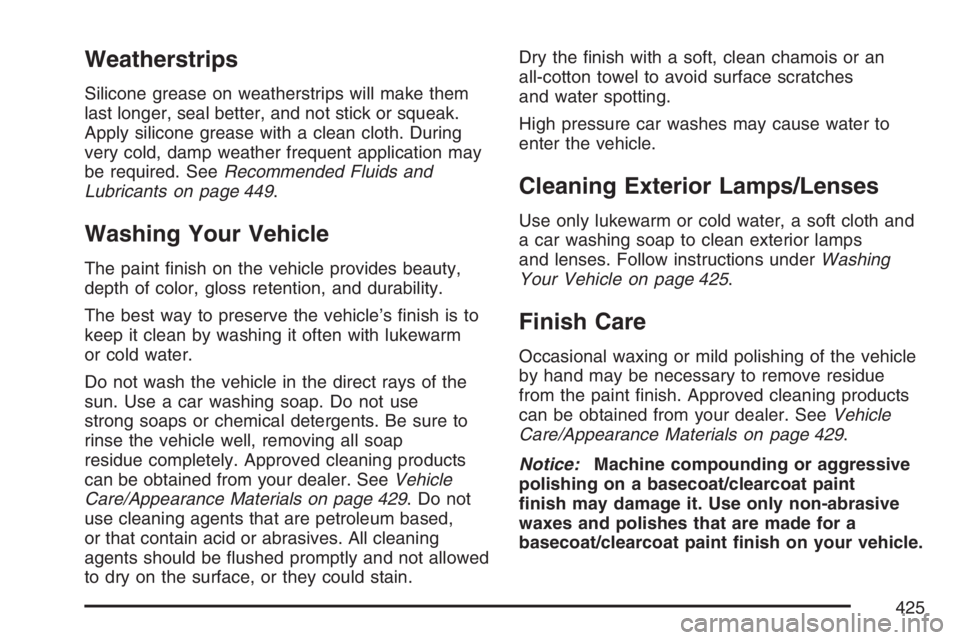
Weatherstrips
Silicone grease on weatherstrips will make them
last longer, seal better, and not stick or squeak.
Apply silicone grease with a clean cloth. During
very cold, damp weather frequent application may
be required. SeeRecommended Fluids and
Lubricants on page 449.
Washing Your Vehicle
The paint �nish on the vehicle provides beauty,
depth of color, gloss retention, and durability.
The best way to preserve the vehicle’s �nish is to
keep it clean by washing it often with lukewarm
or cold water.
Do not wash the vehicle in the direct rays of the
sun. Use a car washing soap. Do not use
strong soaps or chemical detergents. Be sure to
rinse the vehicle well, removing all soap
residue completely. Approved cleaning products
can be obtained from your dealer. SeeVehicle
Care/Appearance Materials on page 429.Donot
use cleaning agents that are petroleum based,
or that contain acid or abrasives. All cleaning
agents should be �ushed promptly and not allowed
to dry on the surface, or they could stain.Dry the �nish with a soft, clean chamois or an
all-cotton towel to avoid surface scratches
and water spotting.
High pressure car washes may cause water to
enter the vehicle.
Cleaning Exterior Lamps/Lenses
Use only lukewarm or cold water, a soft cloth and
a car washing soap to clean exterior lamps
and lenses. Follow instructions underWashing
Your Vehicle on page 425.
Finish Care
Occasional waxing or mild polishing of the vehicle
by hand may be necessary to remove residue
from the paint �nish. Approved cleaning products
can be obtained from your dealer. SeeVehicle
Care/Appearance Materials on page 429.
Notice:Machine compounding or aggressive
polishing on a basecoat/clearcoat paint
�nish may damage it. Use only non-abrasive
waxes and polishes that are made for a
basecoat/clearcoat paint �nish on your vehicle.
425
Page 426 of 490
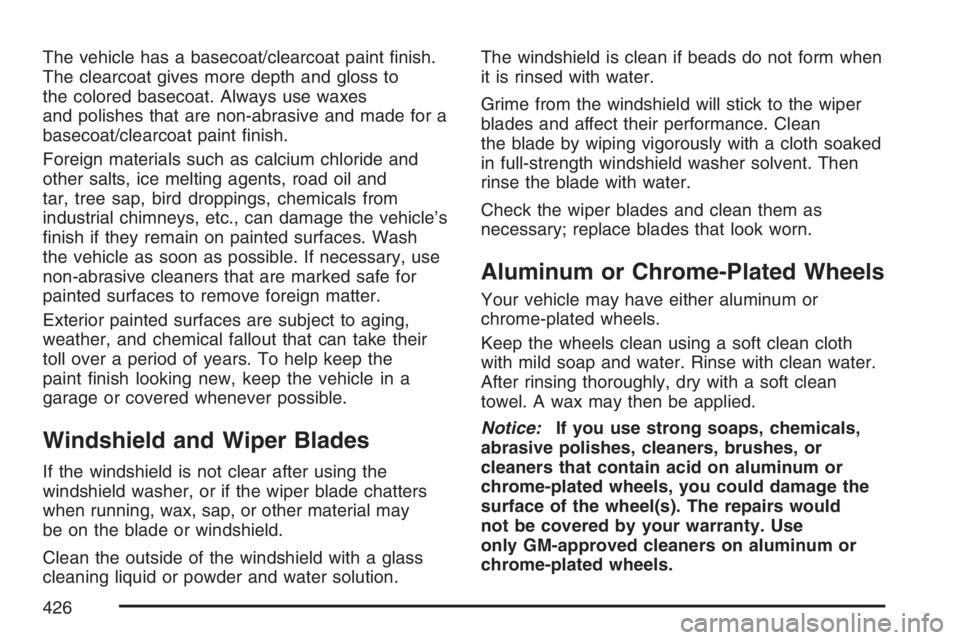
The vehicle has a basecoat/clearcoat paint �nish.
The clearcoat gives more depth and gloss to
the colored basecoat. Always use waxes
and polishes that are non-abrasive and made for a
basecoat/clearcoat paint �nish.
Foreign materials such as calcium chloride and
other salts, ice melting agents, road oil and
tar, tree sap, bird droppings, chemicals from
industrial chimneys, etc., can damage the vehicle’s
�nish if they remain on painted surfaces. Wash
the vehicle as soon as possible. If necessary, use
non-abrasive cleaners that are marked safe for
painted surfaces to remove foreign matter.
Exterior painted surfaces are subject to aging,
weather, and chemical fallout that can take their
toll over a period of years. To help keep the
paint �nish looking new, keep the vehicle in a
garage or covered whenever possible.
Windshield and Wiper Blades
If the windshield is not clear after using the
windshield washer, or if the wiper blade chatters
when running, wax, sap, or other material may
be on the blade or windshield.
Clean the outside of the windshield with a glass
cleaning liquid or powder and water solution.The windshield is clean if beads do not form when
it is rinsed with water.
Grime from the windshield will stick to the wiper
blades and affect their performance. Clean
the blade by wiping vigorously with a cloth soaked
in full-strength windshield washer solvent. Then
rinse the blade with water.
Check the wiper blades and clean them as
necessary; replace blades that look worn.
Aluminum or Chrome-Plated Wheels
Your vehicle may have either aluminum or
chrome-plated wheels.
Keep the wheels clean using a soft clean cloth
with mild soap and water. Rinse with clean water.
After rinsing thoroughly, dry with a soft clean
towel. A wax may then be applied.
Notice:If you use strong soaps, chemicals,
abrasive polishes, cleaners, brushes, or
cleaners that contain acid on aluminum or
chrome-plated wheels, you could damage the
surface of the wheel(s). The repairs would
not be covered by your warranty. Use
only GM-approved cleaners on aluminum or
chrome-plated wheels.
426
Page 427 of 490
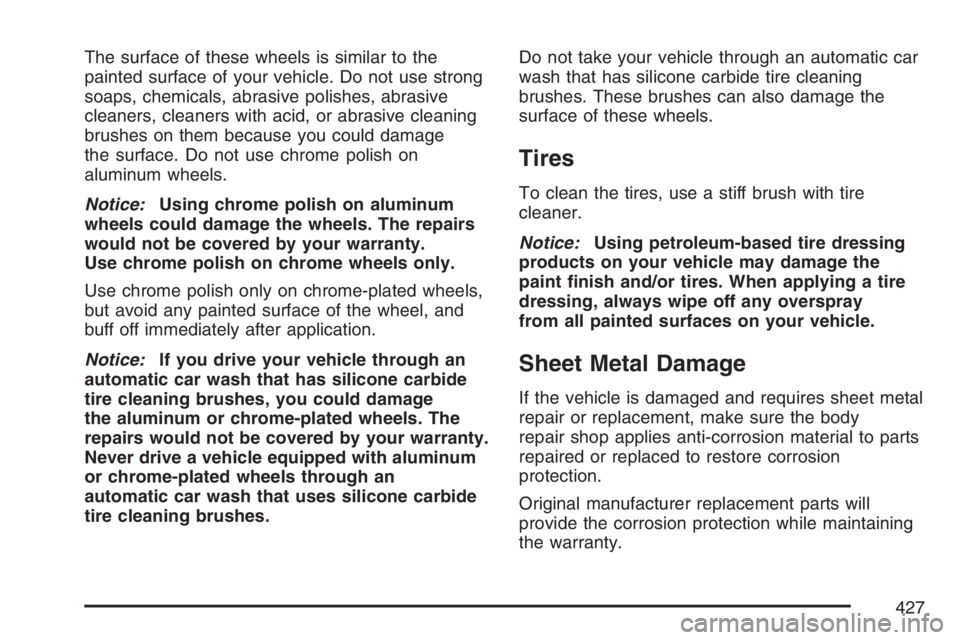
The surface of these wheels is similar to the
painted surface of your vehicle. Do not use strong
soaps, chemicals, abrasive polishes, abrasive
cleaners, cleaners with acid, or abrasive cleaning
brushes on them because you could damage
the surface. Do not use chrome polish on
aluminum wheels.
Notice:Using chrome polish on aluminum
wheels could damage the wheels. The repairs
would not be covered by your warranty.
Use chrome polish on chrome wheels only.
Use chrome polish only on chrome-plated wheels,
but avoid any painted surface of the wheel, and
buff off immediately after application.
Notice:If you drive your vehicle through an
automatic car wash that has silicone carbide
tire cleaning brushes, you could damage
the aluminum or chrome-plated wheels. The
repairs would not be covered by your warranty.
Never drive a vehicle equipped with aluminum
or chrome-plated wheels through an
automatic car wash that uses silicone carbide
tire cleaning brushes.Do not take your vehicle through an automatic car
wash that has silicone carbide tire cleaning
brushes. These brushes can also damage the
surface of these wheels.
Tires
To clean the tires, use a stiff brush with tire
cleaner.
Notice:Using petroleum-based tire dressing
products on your vehicle may damage the
paint �nish and/or tires. When applying a tire
dressing, always wipe off any overspray
from all painted surfaces on your vehicle.
Sheet Metal Damage
If the vehicle is damaged and requires sheet metal
repair or replacement, make sure the body
repair shop applies anti-corrosion material to parts
repaired or replaced to restore corrosion
protection.
Original manufacturer replacement parts will
provide the corrosion protection while maintaining
the warranty.
427
Page 428 of 490
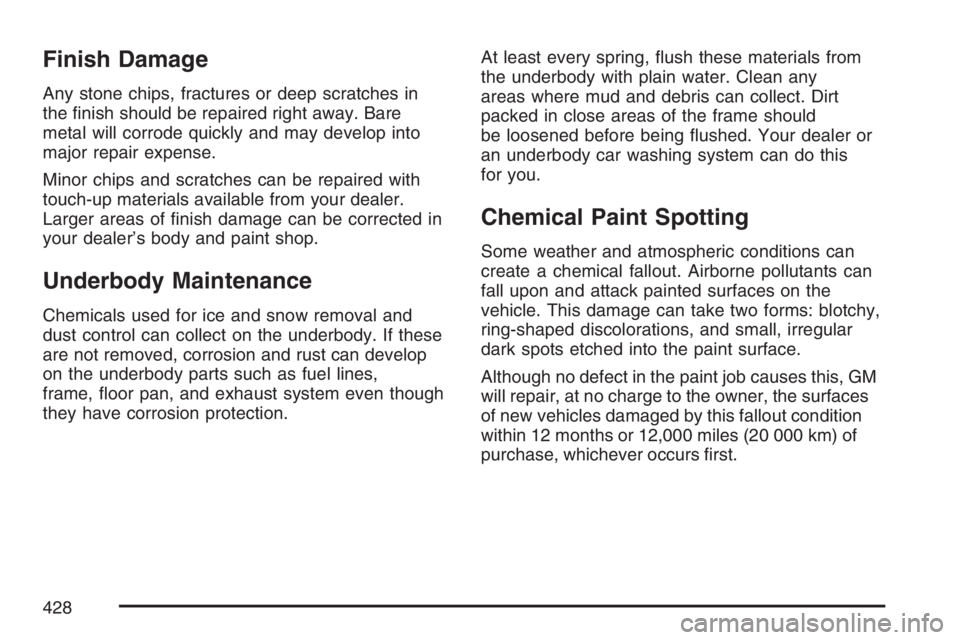
Finish Damage
Any stone chips, fractures or deep scratches in
the �nish should be repaired right away. Bare
metal will corrode quickly and may develop into
major repair expense.
Minor chips and scratches can be repaired with
touch-up materials available from your dealer.
Larger areas of �nish damage can be corrected in
your dealer’s body and paint shop.
Underbody Maintenance
Chemicals used for ice and snow removal and
dust control can collect on the underbody. If these
are not removed, corrosion and rust can develop
on the underbody parts such as fuel lines,
frame, �oor pan, and exhaust system even though
they have corrosion protection.At least every spring, �ush these materials from
the underbody with plain water. Clean any
areas where mud and debris can collect. Dirt
packed in close areas of the frame should
be loosened before being �ushed. Your dealer or
an underbody car washing system can do this
for you.
Chemical Paint Spotting
Some weather and atmospheric conditions can
create a chemical fallout. Airborne pollutants can
fall upon and attack painted surfaces on the
vehicle. This damage can take two forms: blotchy,
ring-shaped discolorations, and small, irregular
dark spots etched into the paint surface.
Although no defect in the paint job causes this, GM
will repair, at no charge to the owner, the surfaces
of new vehicles damaged by this fallout condition
within 12 months or 12,000 miles (20 000 km) of
purchase, whichever occurs �rst.
428
Page 429 of 490
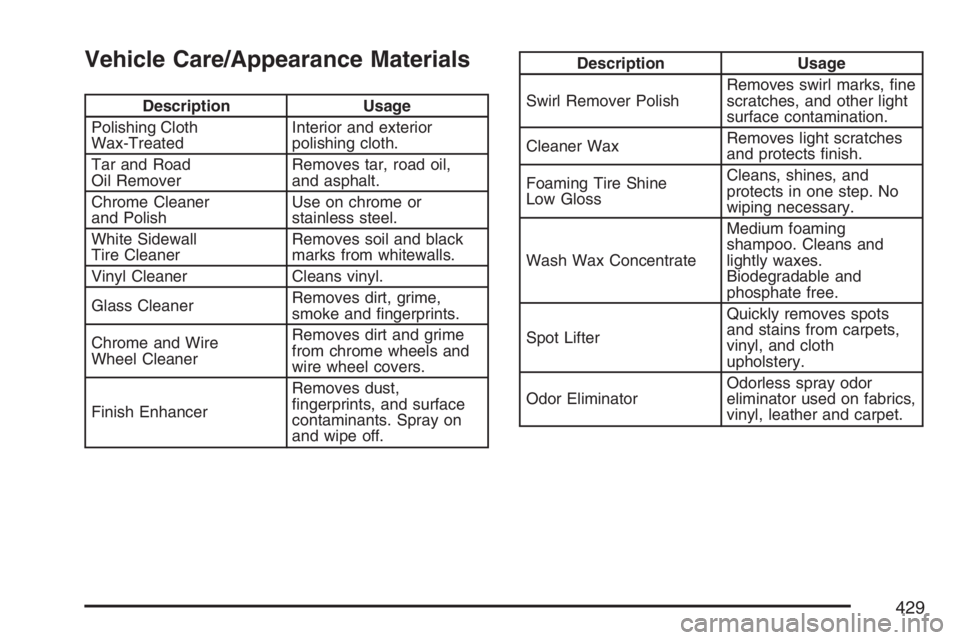
Vehicle Care/Appearance Materials
Description Usage
Polishing Cloth
Wax-TreatedInterior and exterior
polishing cloth.
Tar and Road
Oil RemoverRemoves tar, road oil,
and asphalt.
Chrome Cleaner
and PolishUse on chrome or
stainless steel.
White Sidewall
Tire CleanerRemoves soil and black
marks from whitewalls.
Vinyl Cleaner Cleans vinyl.
Glass CleanerRemoves dirt, grime,
smoke and �ngerprints.
Chrome and Wire
Wheel CleanerRemoves dirt and grime
from chrome wheels and
wire wheel covers.
Finish EnhancerRemoves dust,
�ngerprints, and surface
contaminants. Spray on
and wipe off.
Description Usage
Swirl Remover PolishRemoves swirl marks, �ne
scratches, and other light
surface contamination.
Cleaner WaxRemoves light scratches
and protects �nish.
Foaming Tire Shine
Low GlossCleans, shines, and
protects in one step. No
wiping necessary.
Wash Wax ConcentrateMedium foaming
shampoo. Cleans and
lightly waxes.
Biodegradable and
phosphate free.
Spot LifterQuickly removes spots
and stains from carpets,
vinyl, and cloth
upholstery.
Odor EliminatorOdorless spray odor
eliminator used on fabrics,
vinyl, leather and carpet.
429
Page 430 of 490
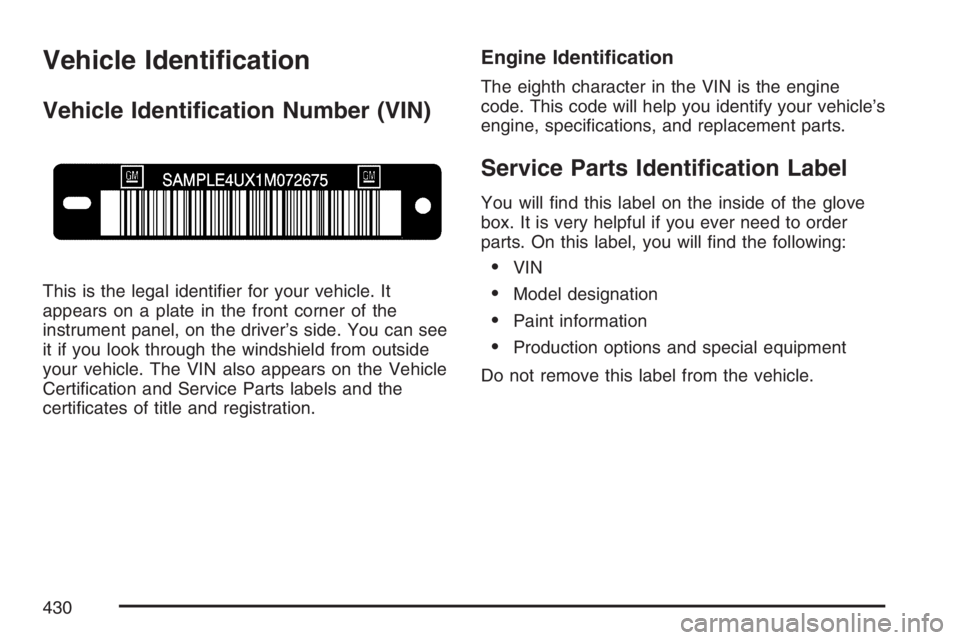
Vehicle Identi�cation
Vehicle Identi�cation Number (VIN)
This is the legal identi�er for your vehicle. It
appears on a plate in the front corner of the
instrument panel, on the driver’s side. You can see
it if you look through the windshield from outside
your vehicle. The VIN also appears on the Vehicle
Certi�cation and Service Parts labels and the
certi�cates of title and registration.
Engine Identi�cation
The eighth character in the VIN is the engine
code. This code will help you identify your vehicle’s
engine, speci�cations, and replacement parts.
Service Parts Identi�cation Label
You will �nd this label on the inside of the glove
box. It is very helpful if you ever need to order
parts. On this label, you will �nd the following:
VIN
Model designation
Paint information
Production options and special equipment
Do not remove this label from the vehicle.
430